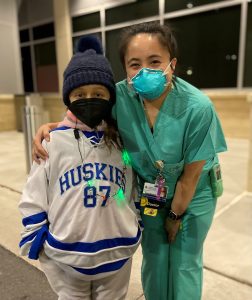It’s rare that Jeanine Reyes-Bautista, a pediatric emergency physician in Howard County General Hospital (HCGH), a Johns Hopkins community hospital in Columbia, Maryland, sees her patients after their visit. Though she’ll often call to follow up after treatment, continuity of care in emergency medicine is limited.
So when the Howard Huskies, a Columbia-based team of 16 and 17-year-old hockey players, returned with care packages following treatment for carbon monoxide exposure, she was touched.

“It’s just really nice to know that what we do day-to-day makes such an impact,” she says.
In the middle of their 2021-2022 season, the Huskies were competing in a two-day hockey tournament in Pennsylvania when members of the team started experiencing headaches, fatigue, and shortness of breath. The players attributed their worsening symptoms to a busy and physically taxing weekend.
But as they headed into their fourth game, the Huskies started to suspect something wasn’t right. Plus, their parents and siblings were starting to experience the same symptoms.
“We usually get tired when we have these tournaments, but we don’t get this tired. It was like everyone was in pain,” Huskies player Parsa Teymourlouei remembers. “We were all a little out of it.”
Players and their families left the ice rink, with some checking into nearby emergency rooms. It was later determined that all the players and families attending the weekend’s tournament, had been exposed to a carbon monoxide leak at the ice rink. From there, word began to spread.
Some of the Huskies had already been admitted to HCGH when they received the call about their exposure, which helped emergency staff expedite diagnosis and treatment. Because carbon monoxide poisoning can be completely asymptomatic or symptoms present as everyday ailments, like headaches and nausea, Reyes-Bautista says it can be tricky to identify, especially in a group of hockey-playing teens.
“Carbon monoxide poisoning from a car running in an enclosed space is preventable, but a carbon monoxide leak at an ice rink is not predictable,” she says.
In addition to running cars, unvented space heaters are also a common source of carbon monoxide exposure, which often occurs in the winter when people are trying to keep warm.
Though carbon monoxide poisoning can be tough to diagnose, quick treatment is imperative. Carbon monoxide binds to hemoglobin — the protein in red blood cells that carries oxygen to the body’s organs and tissues — more strongly than oxygen does, putting the heart, brain, and other organs at risk for damage.
The main intervention for suspected carbon monoxide exposure is oxygen via non-rebreather mask, which covers a patient’s mouth and nose and helps deliver high concentrations of oxygen. Doctors order labs to determine if there is any injury to the patient’s organs, and the duration of treatment depends on symptoms and lab results. If patients have lingering symptoms, they may receive hyperbaric oxygen therapy, which involves entering a special chamber to breath pure oxygen.
At HCGH, the adult and pediatric emergency medicine teams worked together to keep families in the same hospital rooms, helping alleviate parents’ anxieties as they received treatment alongside their children. The plan also helped with rooming, with emergency beds at a premium, Reyes-Bautista says.
“Communication was key in navigating what happened in our emergency room,” she adds. “It’s not something you face every day in a community hospital. I’m grateful that we have such great people in our units. Not just physicians, but charge nurses, nurses, techs. Everyone worked together to streamline the care that those families received that evening.”
Teymourlouei’s mother, Mitra Gavgani, serves as vice president of Pharmacy Services (Community, Infusion and Specialty) at Johns Hopkins Home Care Group. She was inspired by the entire emergency team’s efficient and compassionate response.
By the time the players checked out, she says, the HCGH health care team had become as invested in the weekend’s matchups as the Huskies.
“We have an amazing resource here at Howard County. Working for Hopkins, I always know we do great work,” Gavgani says. “But it is phenomenal to see that they could make it happen that quickly. I’m really proud of the HCGH team and being affiliated with that team. As a member of the community, I find great comfort knowing that we can count on them.”
Other Huskies parents reached out to Gavgani to ask how to best thank the emergency team, who were working long hours due to the COVID-19 spike at the time. To comply with social distancing and infection control policies, the Huskies decided to make them individual care packages.
“We wanted to give back because they treated us so well,” Teymourlouei says. “We thought they deserved it and it was the right thing to do.”
The Huskies delivered the more than 100 care packages to the entire emergency team — from security and registration to the adult and pediatric Emergency Department care staff — outdoors, masked, and in person.
“It was nice to be able to do something,” Gavgani says. “The peak was when we got to deliver to the staff who were actually involved. It couldn’t have been a better way to end that chapter.”
Topics: Friends of Johns Hopkins Medicine, Howard County Medical Center, Johns Hopkins Medicine, Promote and Protect Health